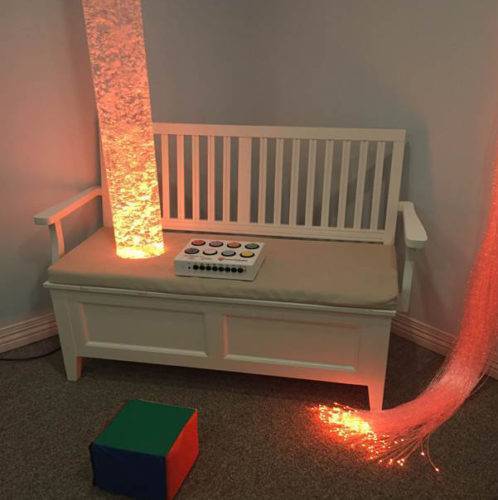Sensory Room Provides Respite
Omaha, Nebraska houses the Rose Blumkin Jewish Home, a skilled nursing facility founded in 1982 and partner of RehabVisions since 1986. Our therapists recently helped Rose Blumkin install a sensory room, a space designed to abate the symptoms of dementia and other cognitive disorders. Occupational Therapist Rosie Gneym chose the sensory room as her passion project, an initiative she pursued during her doctorate program’s professional rotation at Rose Blumkin. The room required extensive design and conceptual research.

Patients can change the colors of the fiber optics to suit their sensory preferences.
Each component of the space was carefully selected. Various items can be found within its four walls, meant to either stimulate or calm, depending on the patient’s sensory needs. These include: aroma therapy oils, a projector featuring wildlife images, color-changing water tubes, an armchair programmed to vibrate in sync with classical music, photo and activity books, a weighted shawl, and other objects to be felt and manipulated by residents. Customized programs are created for each patient, detailing sensory preferences and favorite items and settings within the room; this allows caretakers to best serve anyone who may walk through its doors. Although a soothing atmosphere is best for some, others require the opposite: more stimulation than their current environment provides. In these cases, the room is tailored to awaken the senses through vibrant colors, acidic scents and rugged textures.

A solar projector displays rotating wildlife pictures.
The positive impacts of the sensory room are far-reaching, resulting in short and long-term outcomes for patients. For those with dementia, the space quickly becomes a safe place to relax and reminisce, improving overall mood by reducing anxiety and maladaptive behaviors. Many individuals with high levels of agitation utilize the space prior to therapy sessions, allowing them to enter a calm and adaptive mindset more conducive to therapeutic routines. The sensory room often functions as a proactive tool, curtailing turbulent emotions or unsteady dispositions before situations become disruptive. Some patients even know when they need to take a trip down the hall.
The addition of the sensory room has also been beneficial for both staff and the facility in general. As Sherri Judah, OT explained, “The room’s ability to calm patients and prevent outbursts makes the nursing staff’s quality of life better, too.” In the near future, Rose and Sherri are hoping to participate in a research project collecting data on the outcomes of the sensory room. Thus far, those involved consider it nothing but an asset and an advantage to the Rose Blumkin Jewish Home.